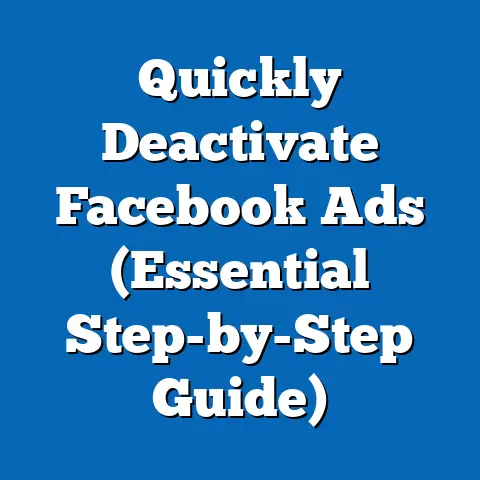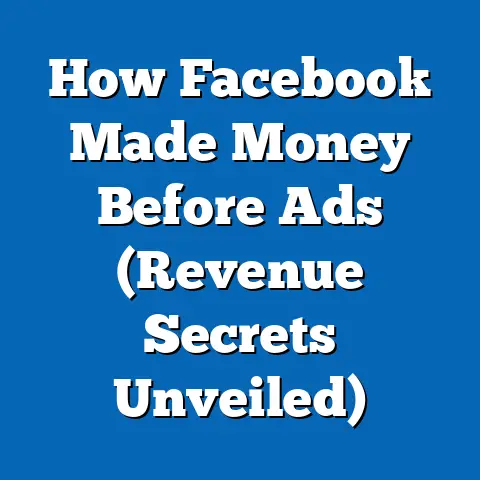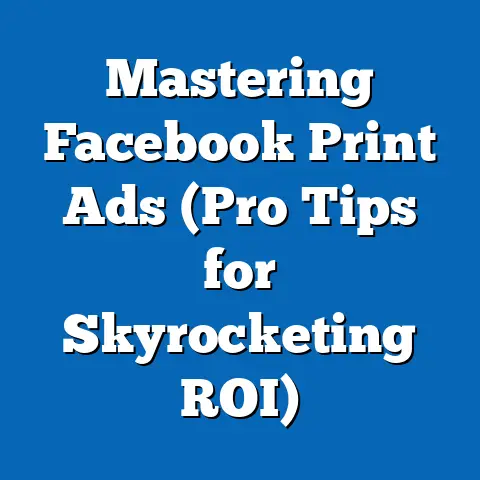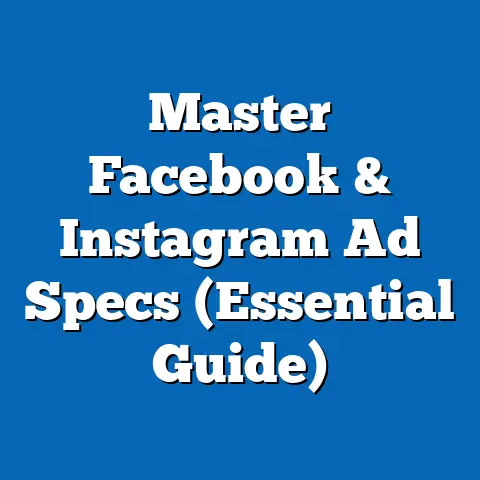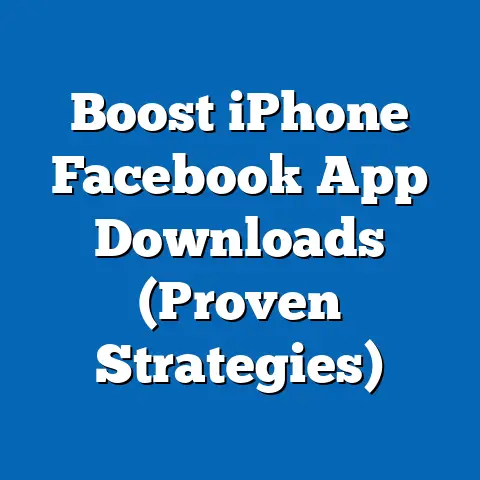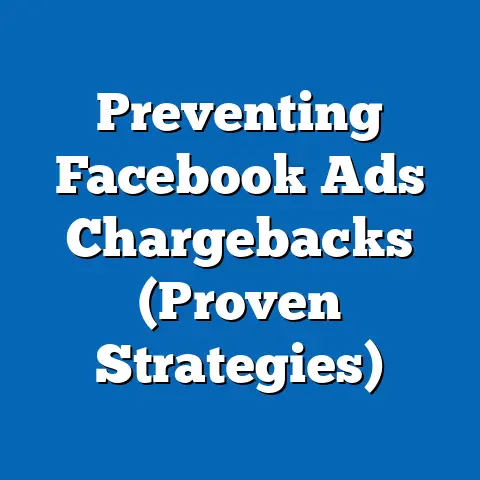Unlocking Facebook Ads: Maximize Page’s Potential (Expert Tips)
Facebook. It’s more than just a social network; it’s a digital town square, a place where billions connect, share, and discover. And for businesses like yours, it’s an unparalleled advertising platform. I’ve seen firsthand how Facebook Ads can be a game-changer, transforming small startups into recognized brands and boosting sales for established companies. The beauty of Facebook Ads lies in its accessibility. It’s not just for big corporations with massive marketing budgets; it’s a tool available to entrepreneurs, marketers, and brands of all sizes.
I remember working with a local bakery that was struggling to get customers through the door. They had amazing products, but no one knew they existed! We started a simple Facebook Ads campaign, targeting people within a 5-mile radius who had interests in baking, desserts, and local businesses. The results were incredible! Within weeks, they saw a significant increase in foot traffic and online orders. It was a testament to the power of targeted advertising and the ease with which Facebook Ads can connect businesses with their ideal customers.
Setting up ads on Facebook is surprisingly straightforward, making it easy to tap into the platform’s vast audience. But, like any powerful tool, understanding how to use it effectively is key. That’s what this guide is all about – unlocking the potential of Facebook Ads to maximize your page’s reach, engagement, and ultimately, your business success. Let’s dive in!
Understanding the Basics of Facebook Ads
Okay, let’s start with the fundamentals. What exactly are Facebook Ads?
Simply put, Facebook Ads are paid messages that businesses display on Facebook and its affiliated platforms (like Instagram, Audience Network, and Messenger). They are designed to reach a specific audience based on a variety of factors, including demographics, interests, behaviors, and location. Unlike organic posts, which are only seen by people who already follow your page, Facebook Ads allow you to reach a much wider audience – even those who have never heard of your business before.
Types of Facebook Ads
Facebook offers a variety of ad formats to choose from, each with its own strengths and best-use cases. Here’s a quick rundown:
- Image Ads: These are the simplest type of ad, featuring a single image and accompanying text. They’re great for showcasing a product or service in a visually appealing way.
- Video Ads: Video ads are incredibly engaging and can be used to tell a story, demonstrate a product, or share a testimonial. Short, attention-grabbing videos tend to perform best.
- Carousel Ads: Carousel ads allow you to showcase multiple images or videos in a single ad unit. Users can swipe through the carousel to see different products or features.
- Slideshow Ads: Similar to video ads, slideshow ads combine multiple images into a video-like format. They’re a cost-effective way to create engaging content without the expense of video production.
- Collection Ads: These ads are designed for e-commerce businesses and allow users to browse and purchase products directly from the ad.
- Lead Ads: Lead ads are designed to collect leads directly on Facebook. Users can fill out a form with their contact information without ever leaving the platform.
- Instant Experience Ads: These are full-screen, mobile-optimized ads that load instantly, providing a seamless and immersive experience for users.
Choosing the right ad format depends on your goals, your target audience, and the type of content you want to share.
Setting Clear Goals
Before you even think about creating an ad, it’s crucial to define your goals. What do you want to achieve with your Facebook Ads campaign? Are you looking to:
- Increase brand awareness?
- Generate leads?
- Drive traffic to your website?
- Increase sales?
- Promote an event?
Your goals will influence everything from your ad creative to your targeting strategy to your bidding approach. For example, if your goal is to increase brand awareness, you might focus on reaching a broad audience with visually appealing ads. If your goal is to generate leads, you might use lead ads and target users who are likely to be interested in your product or service.
Understanding User Demographics
Facebook boasts a massive and diverse user base, with billions of active users worldwide. Understanding the demographics of Facebook users is essential for targeting the right audience and maximizing the effectiveness of your ads.
While demographics vary by region and interest, it’s important to consider factors like age, gender, location, education level, and interests when crafting your ad strategy. Facebook provides detailed demographic data that can help you tailor your ads to the right people. For instance, I’ve found that targeting specific age groups and interests based on product type can significantly improve conversion rates.
Key Takeaway: Facebook Ads are a powerful tool for reaching a vast audience. Understanding the different ad types, setting clear goals, and knowing your target audience are essential first steps.
Crafting Compelling Ad Content
Now that you understand the basics, let’s talk about creating ad content that grabs attention and drives results. In a world saturated with digital noise, your ads need to stand out from the crowd.
Eye-Catching Visuals
Visuals are the first thing people see, so make them count. Use high-quality images or videos that are relevant to your product or service and visually appealing to your target audience. Avoid blurry or pixelated images, and make sure your visuals are properly sized for the ad format you’re using.
I’ve found that using real photos of your products or services often performs better than stock photos. People want to see what they’re actually getting. Also, consider using bright colors and bold designs to capture attention.
Engaging Ad Copy
Your ad copy should be clear, concise, and compelling. Highlight the benefits of your product or service, and tell people why they should care. Use strong verbs and action-oriented language to encourage engagement.
Don’t be afraid to use humor or emotion to connect with your audience. But always make sure your tone is appropriate for your brand and your target audience.
The Power of Storytelling
People connect with stories. Instead of simply listing the features of your product or service, try telling a story that resonates with your audience. How does your product solve a problem? How does it make people’s lives better?
I once worked with a travel company that was struggling to attract new customers. We created a series of video ads that told the stories of real travelers who had used their services. The ads were incredibly successful because they tapped into people’s desire for adventure and connection.
Effective Calls-to-Action (CTAs)
Your call-to-action (CTA) is the final nudge that encourages people to take action. Use clear and concise CTAs that tell people exactly what you want them to do.
Examples of effective CTAs include:
- Shop Now
- Learn More
- Sign Up
- Get Started
- Download Now
Make sure your CTA is visually prominent and easy to click.
Key Takeaway: Compelling ad content is essential for capturing attention and driving results. Use high-quality visuals, engaging ad copy, storytelling, and effective CTAs to maximize the impact of your ads.
Targeting Your Audience
One of the biggest advantages of Facebook Ads is its powerful targeting capabilities. You can target your ads to a specific audience based on a variety of factors, ensuring that your message reaches the people who are most likely to be interested in your product or service.
Targeting Options
Facebook offers a wide range of targeting options, including:
- Demographics: Target people based on age, gender, location, education level, relationship status, and more.
- Interests: Target people based on their interests, hobbies, and pages they like on Facebook.
- Behaviors: Target people based on their online behavior, such as purchase history, device usage, and travel habits.
- Custom Audiences: Create custom audiences based on your existing customer data, such as email lists or website visitors.
- Lookalike Audiences: Create lookalike audiences based on your custom audiences. Facebook will find people who are similar to your existing customers.
Facebook Pixel
The Facebook Pixel is a small piece of code that you can install on your website to track conversions and retarget users. It allows you to see what actions people are taking on your website after clicking on your Facebook ad.
With the Facebook Pixel, you can:
- Track conversions: See how many people are making purchases, filling out forms, or taking other desired actions on your website.
- Retarget users: Show ads to people who have visited your website or taken specific actions, such as adding items to their cart but not completing the purchase.
- Optimize your ads: Use conversion data to optimize your ads and improve your return on investment.
Lookalike Audiences
Lookalike audiences are one of the most powerful targeting tools on Facebook. They allow you to reach new people who are similar to your existing customers.
To create a lookalike audience, you first need to create a custom audience based on your existing customer data. Then, you can tell Facebook to find people who are similar to that audience.
I’ve seen incredible results with lookalike audiences. They’re a great way to expand your reach and find new customers who are likely to be interested in your product or service.
Testing and Optimization
Targeting is not a one-size-fits-all approach. You need to test different targeting strategies to determine what works best for your brand.
Try creating multiple ad sets with different targeting options. Then, monitor the performance of each ad set and adjust your targeting accordingly. You may find that certain demographics or interests perform better than others.
Key Takeaway: Targeting is key to reaching the right audience and maximizing the effectiveness of your ads. Use the various targeting options available on Facebook, install the Facebook Pixel, create lookalike audiences, and test different targeting strategies to optimize your campaigns.
Budgeting and Bidding Strategies
Now, let’s talk about the financial side of Facebook Ads. How much should you spend, and how should you bid for ad placements?
Budgeting Options
Facebook offers two main budgeting options:
- Daily Budget: Set a daily budget, and Facebook will spend that amount each day.
- Lifetime Budget: Set a lifetime budget, and Facebook will spend that amount over the entire duration of your campaign.
The best option depends on your goals and your campaign duration. If you’re running a short-term campaign, a lifetime budget might be the best choice. If you’re running a long-term campaign, a daily budget might be more appropriate.
I generally recommend starting with a daily budget and then adjusting it based on performance.
Bidding Strategies
Facebook uses an auction system to determine which ads are shown to users. You bid for ad placements, and the highest bidder wins.
Facebook offers several bidding strategies:
- Cost Per Click (CPC): You pay each time someone clicks on your ad.
- Cost Per Thousand Impressions (CPM): You pay for every 1,000 times your ad is shown.
- Cost Per Action (CPA): You pay each time someone takes a specific action, such as making a purchase or filling out a form.
The best bidding strategy depends on your goals and your budget. If you’re focused on driving traffic to your website, CPC might be the best choice. If you’re focused on increasing brand awareness, CPM might be more appropriate. If you’re focused on driving conversions, CPA might be the best option.
Optimizing Ad Spend
Optimizing your ad spend is essential for maximizing your return on investment. Here are a few tips:
- Monitor your ad performance: Track your key metrics, such as click-through rate, conversion rate, and cost per conversion.
- Adjust your bidding strategy: If you’re not getting the results you want, try adjusting your bidding strategy.
- Pause underperforming ads: If certain ads are not performing well, pause them and focus on the ads that are driving results.
- Refine your targeting: Make sure you’re targeting the right audience.
- Test different ad creatives: Try different images, videos, and ad copy to see what resonates best with your audience.
Data-Driven Decisions
The key to successful Facebook Ads is making data-driven decisions. Don’t just guess what’s working; track your performance and use the data to optimize your campaigns.
Key Takeaway: Budgeting and bidding strategies are crucial for maximizing your return on investment. Choose the right budgeting option, select the appropriate bidding strategy, optimize your ad spend, and make data-driven decisions.
Analyzing and Optimizing Ad Performance
You’ve launched your campaign, but the work doesn’t stop there. Analyzing and optimizing your ad performance is crucial for long-term success. This is where Facebook Ads Manager comes into play.
Facebook Ads Manager
Facebook Ads Manager is your central hub for creating, managing, and tracking your Facebook Ads campaigns. It provides a wealth of data and insights that can help you optimize your ads and improve your results.
In Ads Manager, you can:
- Track your ad performance: See how your ads are performing in terms of impressions, clicks, conversions, and more.
- Analyze your audience: Get insights into the demographics, interests, and behaviors of the people who are seeing your ads.
- Manage your budget: Adjust your budget and bidding strategy.
- A/B test different ad components: Test different images, videos, ad copy, and targeting options to see what works best.
- Generate reports: Create custom reports to track your key metrics and identify areas for improvement.
Key Metrics to Monitor
There are several key metrics that you should monitor in Facebook Ads Manager:
- Impressions: The number of times your ad is shown.
- Reach: The number of unique people who see your ad.
- Click-Through Rate (CTR): The percentage of people who click on your ad after seeing it.
- Conversion Rate: The percentage of people who take a desired action (such as making a purchase or filling out a form) after clicking on your ad.
- Cost Per Click (CPC): The amount you pay each time someone clicks on your ad.
- Cost Per Conversion (CPA): The amount you pay each time someone takes a desired action after clicking on your ad.
- Engagement Rate: The percentage of people who interact with your ad (such as liking, commenting, or sharing).
A/B Testing
A/B testing is a powerful technique for improving your ad performance. It involves testing different versions of your ad to see which one performs better.
For example, you could test two different images, two different headlines, or two different calls-to-action. Run both versions of the ad simultaneously and track their performance. The version that performs better is the one you should use.
I’ve found that A/B testing can lead to significant improvements in ad performance. It’s a great way to identify what resonates best with your audience.
Continuous Optimization
The key to successful Facebook Ads is continuous optimization. Don’t just set it and forget it. Regularly monitor your ad performance and make adjustments as needed.
Key Takeaway: Analyzing and optimizing your ad performance is crucial for long-term success. Use Facebook Ads Manager to track your performance, analyze your audience, A/B test different ad components, and continuously optimize your campaigns.
Conclusion
Facebook Ads are a powerful tool that can help you maximize your brand’s online presence, but only if you use them effectively. I’ve shared my experiences, tips, and strategies to guide you on your journey to unlocking your page’s full potential.
Remember, it’s not just about setting up an ad; it’s about understanding your audience, crafting compelling content, targeting the right people, managing your budget wisely, and continuously analyzing and optimizing your performance.
I encourage you to embrace the tips and strategies discussed in this article and take your Facebook ad campaigns to the next level. And don’t be afraid to experiment! The best way to learn is by doing.
Now, I’d love to hear from you. What are your experiences with Facebook Ads? What challenges have you faced? What successes have you achieved? Share your stories in the comments below or on social media. Let’s learn from each other and build a community of successful Facebook advertisers! The world of Facebook Ads is constantly evolving, so let’s stay connected, share our knowledge, and continue to unlock the potential of this powerful platform together.

